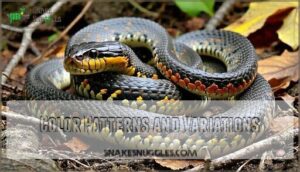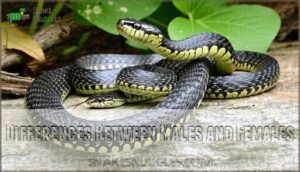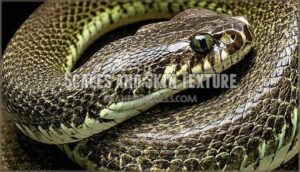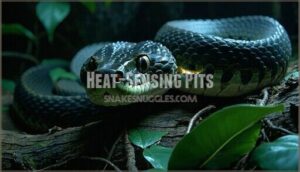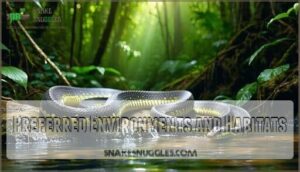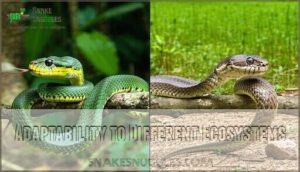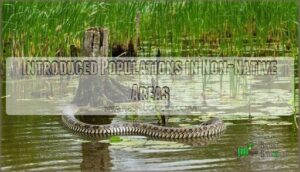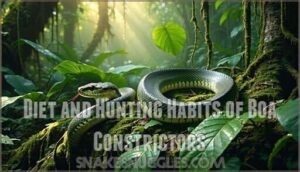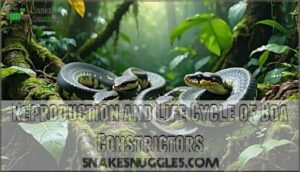This site is supported by our readers. We may earn a commission, at no cost to you, if you purchase through links.

From their glossy, color-shifting scales to their role keeping rodent populations in check across Central and South America, boas balance power with adaptability.
You’ll discover how females dwarf males, why their constriction doesn’t actually break bones, and what makes island populations look dramatically different from their mainland cousins—each fact challenging what you thought you knew.
Table Of Contents
- Key Takeaways
- Physical Characteristics of Boa Constrictors
- Habitat and Distribution of Boa Constrictors
- Diet and Hunting Habits of Boa Constrictors
- Reproduction and Life Cycle of Boa Constrictors
- Conservation Status and Human Interaction
- Frequently Asked Questions (FAQs)
- Are boa constrictors a snake?
- Do boa constrictors give birth?
- What makes the Great boa constrictor so fascinating?
- How do boa constrictors grow their families?
- What is boa constrictor conservation?
- Are boa constrictors fast?
- What are some cool facts about the boa constrictor?
- How many hearts does a boa constrictor have?
- How long do boa snakes live?
- How fast can a boa go?
- Conclusion
Key Takeaways
- Boa constrictors use heat-sensing facial pits to detect prey in complete darkness, allowing them to hunt effectively at night by creating thermal "images" that supplement their regular vision.
- Female boas can reproduce through parthenogenesis (virgin birth) without mating, and they give live birth to 10-65 young after a 5-8 month gestation period instead of laying eggs like most reptiles.
- These snakes don’t actually crush or suffocate their prey—instead, their constriction cuts off blood flow with each tightening coil, stopping the heart through circulatory arrest rather than breaking bones.
- Boas serve as natural pest control by significantly reducing rodent populations, with studies showing up to 40% fewer grain losses for farmers and measurable drops in disease-carrying rodent numbers where healthy boa populations exist.
Physical Characteristics of Boa Constrictors
These snakes pack serious muscle under patterned skin that blends into just about anything. Their bodies tell the story of thousands of years perfecting the ambush.
Body Size and Weight
When you picture a boa constrictor, you might imagine a massive snake capable of swallowing prey whole—and you wouldn’t be far off. These muscular reptiles can stretch up to 13 feet long and tip the scales at over 100 pounds. Females usually outgrow males, sometimes dramatically so, making them the heavyweights of their species.
Key size facts include:
- Average length: 6 to 10 feet in most adults
- Maximum weight: Over 100 pounds for large females
- Growth patterns: Steady growth throughout early years
- Body mass distribution: Thickness concentrated mid-body for constriction power
Color Patterns and Variations
Boa constrictors have developed impressive camouflage that helps them survive in different environments. Their colors—browns, tans, reds, and grays—match the landscapes where they live, while their smooth scales display saddle-shaped or diamond patterns that vary by location.
These patterns work so well that the snakes can blend into leaf litter or tree bark, staying hidden from both the animals they hunt and the predators that hunt them.
| Habitat Type | Common Colors | Pattern Style |
|---|---|---|
| Tropical Rainforest | Deep greens, rich browns | Dense saddle marks |
| Dry Savanna | Pale tans, sandy yellows | Faded diamond shapes |
| Rocky Foothills | Gray-silver, rust tones | Irregular blotches |
| Island Populations | Variable reds, darker hues | Unique local patterns |
Between the color patterns and scale texture, boas basically disappear into their surroundings—whether that’s a rainforest floor or rocky hillside.
Differences Between Males and Females
Size tells the story here—female boa constrictors grow noticeably larger than males, often stretching several feet longer.
This difference isn’t random. Females need robust bodies to carry developing young through gestation, so sexual dimorphism becomes a matter of reproductive necessity rather than coincidence.
Males, meanwhile, sport visible anal spurs near their tails, vestigial leg remnants used during mating rituals to stimulate females.
Notably, female boa constrictors can even achieve virgin birth through parthenogenesis when males aren’t available.
Scales and Skin Texture
Touch a boa constrictor’s scales and you’ll feel something unexpected—smooth, almost waxy. That sleek surface lets them slip through jungle branches without catching on anything. Pretty, sure, but mostly practical.
A few things worth knowing about their skin:
- Shedding cycles show how healthy they are—old scales peel away as they grow
- Textured camouflage makes their patterns disappear into tree bark and leaves, perfect for ambush hunting
- Coloration diversity ranges from muddy browns to bright greens, depending on where they live
Once you understand these details, their camouflage makes a lot more sense.
Heat-Sensing Pits
When darkness falls across the rainforest, these serpents flip on their built-in thermal cameras—specialized heat-sensing pits lining their mouths that detect the faint warmth of mammals and birds hiding in complete blackness.
Boa constrictors hunt in total darkness using built-in thermal cameras—heat-sensing pits that detect prey by body warmth alone
These heat-sensing pits work like nature’s infrared goggles. Thermoreceptors inside them pick up body heat and convert it into signals the snake’s brain can read—something our human brains could never do.
The result? A heat-based "image" that overlays their regular vision, letting them strike with deadly accuracy even when prey sits perfectly still. The pits vary slightly from snake to snake, but every boa constrictor has this remarkable adaptation—thermal imaging that turns pitch-black nights into hunting grounds.
Habitat and Distribution of Boa Constrictors
Boa constrictors stretch across an impressive range of the Americas, thriving in ecosystems that might surprise you.
Boa constrictors stretch across an impressive range of the Americas, thriving in ecosystems that might surprise you.
These adaptable serpents have carved out homes across wildly different landscapes—from tropical rainforests to arid scrublands.
Native Range and Geographic Distribution
Stretching across nearly every corner of Central and South America, these exceptional snakes have carved out one of the most impressive territories in the reptile world. You’ll find boa constrictors from northern Mexico down to Argentina, though they skip Chile and certain Argentine regions.
Their native range also includes many Caribbean islands, where geographic isolation has created unique island populations with distinct traits.
These adaptable reptiles dominate tropical ecosystems across varied climate zones and elevation ranges, making them the most widely distributed of all neotropical boas.
Preferred Environments and Habitats
From the steam depths of Amazon rainforests to the dry edges of open savannas, boa constrictors make themselves at home in an impressive variety of landscapes. You’ll spot them thriving in tropical rainforests where vegetation density provides perfect cover, but they’re equally comfortable in grasslands and scrublands.
These snakes gravitate toward areas with reliable water sources and abundant prey, often hunting along forest floors where small mammals scurry about. Dense vegetation aids their ambush hunting style, letting them blend seamlessly into their surroundings.
Adaptability to Different Ecosystems
Boa constrictors are nature’s master adapters, flexing their survival skills across ecosystems that would leave most reptiles struggling. Their ectothermic physiology and environmental resilience let them conquer diverse terrain, from humid jungles to dry grasslands. Here’s how their adaptability shines:
Boa constrictors pull off something most reptiles can’t—thriving in wildly different environments. Cold-blooded metabolism actually helps here, letting them adjust to steamy rainforests or dry grasslands without breaking a sweat (well, metaphorically speaking).
Their range proves the point: Mexico down to Argentina, handling tropical lowlands and cooler mountain slopes alike.
- Climate tolerance runs from tropical heat to Andean foothills
- Geographic spread covers Mexico to Argentina across diverse ecosystems
- Ecological flexibility works across different elevations and humidity levels
- Island populations evolve distinct traits through habitat isolation
- They even persist in human-dominated areas, showing real conservation resilience
Bottom line? These snakes handle an impressive range of conditions.
Human Impact on Boa Constrictor Habitats
You mightn’t realize it, but human expansion is reshaping boa constrictor habitats and distribution at an alarming pace. Deforestation for agriculture eliminates up to 15% of their habitat per decade in parts of the Amazon, while habitat fragmentation reduces genetic diversity by roughly 25%.
Urbanization impacts add another layer of danger—vehicle collisions and intentional killings push local populations down by 60% near growing communities. Wildlife trade pulls thousands from the wild annually, and climate change consequences could make 20% of their current range unsuitable by 2050, making conservation efforts more urgent than ever.
The proposed removal of species from the endangered list, such as the Puerto Rican boa, highlights the importance of wildlife conservation efforts in protecting these animals.
Introduced Populations in Non-Native Areas
You’ve probably walked past an exotic pet store without realizing that boa constrictors, once confined to Central and South America, now call unexpected corners of the globe—including Florida’s Everglades—their new home. The pet trade fuels this geographic distribution shift, turning these snakes into invasive species when released or escaped. Climate adaptation allows them to thrive despite human expansion and habitat loss.
Invasive impacts include:
- Island ecosystems face severe disruption as boas prey on native birds and mammals with no natural predators to control them
- Eradication efforts in Florida cost millions annually, requiring trained teams to hunt and remove established populations
- Pet trade regulations tighten globally, though enforcement gaps still allow thousands to enter non-native territories each year
Diet and Hunting Habits of Boa Constrictors
Boa constrictors are skilled hunters with a diverse menu, relying on patience and power to capture prey.
So what’s on the menu, and how do they actually hunt? These snakes play a surprisingly important role in keeping their ecosystems balanced.
Prey Preferences and Hunting Strategies
If you’ve ever wondered what a boa constrictor chooses for its next meal, you’ll find these snakes aren’t picky eaters—they’ll tackle anything from a scurrying mouse to a surprised bird.
Their boa constrictor diet spans small mammals like rodents and a variety of birds, adapting to whatever prey is available in their territory.
Using nocturnal hunting and sharp prey detection through vision, scent, and heat-sensing pits, they’re masters of ambush tactics, waiting patiently for the perfect moment to strike.
Ambush Predation and Constriction Techniques
Once their prey wanders within striking distance, boa constrictors become living vices, coiling their muscular bodies around their target with lightning speed and unrelenting pressure. Each coil tightens with every exhale, cutting off blood flow rather than suffocating victims outright—a common misconception.
This constriction technique requires immense strength and precision, sensing the slightest heartbeat through pressure-sensitive scales.
Their ambush hunting relies on patience and stealth tactics, blending seamlessly into surroundings until the perfect moment arrives.
Role in Controlling Rodent Populations
Aside from being skilled hunters, boa constrictors play a big role as natural pest controllers in Central and South America. Here’s how they help keep rodent numbers down:
- Dietary preference: Mammals, particularly rodents, make up about one-third of their prey intake across various habitats.
- Disease vector reduction: By suppressing rodent numbers, boas indirectly lower transmission rates of rodent-borne illnesses like leishmaniasis.
- Agricultural benefits: Farmers in rural South America report up to 40% fewer grain losses when boas patrol storage facilities.
- Population dynamics: Studies show rodent populations drop measurably within three years wherever healthy boa populations exist.
- Economic impact: Reduced crop damage means lower costs for pest management and less reliance on chemical rodenticides.
This rodent population control creates ripple effects throughout the ecosystem, maintaining prey balance and preventing outbreaks that could devastate local agriculture. Their diet primarily consists of small mammals, helping to regulate these populations.
Feeding Habits in Captivity
Captive environments shift the menu dramatically, swapping unpredictable wild hunts for a more controlled feeding schedule that keeps your boa healthy without the chase. Here’s what you need to know about their captive care:
- Captive prey variety: Frozen-thawed rodents, from mice to rats, dominate the boa constrictor diet.
- Feeding frequency: Juveniles eat weekly, while adults thrive on bi-weekly meals, preventing obesity concerns.
- Supplementation needs: Quality prey eliminates vitamin gaps in most cases.
- Enrichment strategies: Occasional prey placement variations mimic natural snake diet challenges.
Unique Characteristics of Boa Constrictor Digestion
When a meal vanishes whole—fur, feathers, bones, and all—you’d think digestion would be a nightmare, but boa constrictors have evolved some of the most efficient processing systems in the reptile world. Their stomach acid strength rivals battery acid, breaking down even dense bone material within days.
Here’s how their biology manages the job:
| Digestive Feature | What Happens |
|---|---|
| Circulatory Arrest Trigger | Constriction stops prey’s heartbeat before swallowing |
| Prey Digestion Time | Complete processing takes 4-6 days for average meals |
| Post-Feeding Behavior | Boas rest motionless, directing energy toward digestion |
All of this makes boas remarkably efficient predators—their whole system is built around turning a large meal into energy with minimal waste.
Reproduction and Life Cycle of Boa Constrictors
Boa constrictors have a pretty cool approach to reproduction that shows how they’ve adapted to survive in the wild.
From their first courtship rituals all the way to their remarkable lifespans, boa constrictors have a fascinating reproductive journey worth discovering.
Mating Habits and Breeding Season
Boa constrictors don’t advertise when they’re ready to breed, but males have learned to read the signals through a careful combination of scent trails and subtle visual cues that lead them to receptive females during the dry season.
Courtship rituals involve an elegant dance, with the pair weaving their bodies together in intricate patterns that can last for hours.
Surprisingly, females possess an exceptional backup plan: parthenogenesis, allowing reproduction without mating at all, though this remains relatively rare in boa constrictor reproduction.
Gestation Period and Litter Size
After mating wraps up, female boa constrictors settle into a waiting game that stretches anywhere from five to eight months, with the timeline shifting based on how warm or cool their surroundings stay.
This gestation period hinges on temperature, humidity, and the mother’s overall health, factors that also influence litter size. You’ll find litters ranging dramatically from 10 to 65 baby boas, though most average around 25 neonates.
As ovoviviparous reptiles, females give birth to live young rather than laying eggs, and reproductive frequency usually follows cycles that allow recovery between breeding seasons.
Birth and Development of Young Boa Constrictors
Newborns emerge from their mother fully formed and fiercely independent, armed with instincts sharp enough to hunt within hours of their first breath. Each baby boa measures around 15 to 20 inches, already sporting the distinctive patterns that’ll camouflage them throughout life.
- Immediate independence: No parental care needed; they’re solo from day one
- Instant hunting ability: Heat-sensing pits and constriction skills work right away
- High neonate survival: Strong instincts boost their chances in the wild
Remarkably, females can even reproduce through parthenogenesis, a rare virgin birth capability.
Growth Rate and Maturation
From hatchling to heavyweight, a young boa constrictor transforms at a pace that seems almost magical, adding inches with every passing meal. During juvenile development, these ovoviviparous reptiles grow rapidly, gaining up to 12 inches annually in their first three years. Sexual maturity arrives around 3-4 years, influenced by environmental factors and captive growth conditions.
| Growth Stage | Approximate Age |
|---|---|
| Hatchling | 0-6 months |
| Juvenile | 6 months-3 years |
| Sub-adult | 3-4 years |
| Adult | 4+ years |
| Full size | 6-8 years |
Growth factors like temperature, prey availability, and feeding frequency greatly affect how quickly baby boas reach their impressive adult dimensions of 6-10 feet.
Average Lifespan in The Wild and Captivity
In the wild, a boa constrictor’s clock ticks for roughly 20-30 years, but give one a cozy home and proper care, and you might share your life with this special serpent for three decades or more.
Captivity improvements like consistent diet, veterinary care, and stable habitat conditions extend longevity dramatically. Wild lifespan factors—predation, disease, and environmental stress—reduce their years, while the greatest recorded age in captivity reached an impressive 40 years, showcasing how conservation-minded husbandry benefits these striking constrictors.
Conservation Status and Human Interaction
Boa constrictors aren’t endangered, but they face real challenges from habitat loss, the pet trade, and human misunderstandings about their nature.
We’ll dive into how boa constrictors connect with people and what’s being done to help them thrive as our world changes.
Threats to Boa Constrictor Populations
Despite their "Least Concern" status, boa constrictors face mounting pressures that threaten local populations. Habitat destruction from agriculture has claimed over 3 million hectares annually, while wildlife trafficking removes thousands illegally each year. Climate change could eliminate 25% of suitable habitat by 2050, and human conflict—from fear-based killing to vehicle strikes—adds another layer of risk. Here’s what’s putting these impressive constrictors at risk:
- Habitat Destruction – Rainforest clearing eliminates up to 20% of suitable boa habitat in affected regions, fragmenting populations and isolating island subspecies to dangerously low numbers.
- Wildlife Trafficking – Illegal pet trade collection extracts thousands of wild boas annually, with up to 80% sourced illegally, devastating recovery efforts in vulnerable areas.
- Climate Change – Rising temperatures disrupt reproductive timing and reduce prey availability, threatening to shrink the boa’s range by a quarter within decades.
- Human Conflict and Invasive Species – Misidentification leads to unnecessary killing, while introduced predators like mongooses compete for food, lowering survival rates across affected habitats.
CITES Listing and International Trade
To keep boa constrictor trade in check, CITES regulations play an important role. Most populations fall under CITES Appendix II, requiring legal exports with proper permits and non-detriment findings to guarantee wild populations aren’t harmed.
The subspecies Boa constrictor occidentalis receives stricter protection under Appendix I, prohibiting commercial international trade entirely.
Since 1977, these conservation measures have shifted the market toward captive-bred specimens, easing pressure on wild boas while allowing regulated wildlife trade to continue responsibly.
Impact of Introduced Populations on Native Ecosystems
While regulated trade protects wild populations, boa constrictors accidentally or deliberately released into non-native habitats can wreak havoc on local wildlife. These invasive species become ecosystem disruptors, threatening native animals through:
- Prey depletion – Voracious appetites eliminate local mammals and birds
- Competitive exclusion – Outcompeting native predators for resources
- Disease transmission – Introducing pathogens to vulnerable wildlife
- Hybridization risks – Breeding with related species, compromising genetic integrity
When people release these snakes into areas where they don’t belong, the damage can spread quickly if no one steps in to control the problem.
Cultural Significance and Symbolism
These powerful serpents have shaped human spirituality and symbolism for thousands of years. Across the Amazon, indigenous groups see boa constrictors as guardians of rivers and forests, while ancient cultures connected them to creation and transformation.
You’ll find their cultural importance woven through snake folklore worldwide:
- Amazonian tribes revere boas as spiritual protectors and shamanic guides
- Mesoamerican civilizations incorporated snake symbolism into temple art and creation myths
- Modern interpretations blend traditional reverence with contemporary conservation messaging
These cultural depictions remind us that human connections with nature run deeper than ecology alone.
Conservation Efforts and Education
Although habitat protection and legal measures form the foundation of wildlife conservation, education programs and community outreach create lasting change for boa constrictors. Conservation efforts and education work hand-in-hand: when students participate in hands-on snake programs, their fear drops and knowledge soars, transforming future advocates into allies for these misunderstood predators.
Strategic investment in captive breeding has achieved roughly 50% success rates, while habitat restoration efforts—like those that boosted Puerto Rico’s boa population to 30,000—demonstrate what’s possible.
Frequently Asked Questions (FAQs)
Are boa constrictors a snake?
Yes, you’re looking at a genuine snake here. Boa constrictors belong to the Boidae family, making them true snakes with fascinating reptile characteristics that set them apart from other snake species through their unique taxonomy and diverse subspecies variation.
Do boa constrictors give birth?
Unlike egg-laying reptiles, female boa constrictors give live birth through ovoviviparity, producing litters of 10 to 65 neonates after 5 to 8 months of gestation.
Remarkably, parthenogenesis allows virgin birth without mating, demonstrating their reproductive flexibility.
What makes the Great boa constrictor so fascinating?
Boa constrictors captivate us with their unique adaptations—heat-sensing pits, constriction power, and ecological importance as rodent controllers.
Their behavioral complexity, from ambush hunting to live birth, showcases exceptional evolutionary success across diverse habitats.
How do boa constrictors grow their families?
Female boa constrictors give live birth instead of laying eggs, producing litters of 10 to 65 young after a gestation period of five to eight months.
Remarkably, parthenogenesis allows virgin births without mating, though breeding commonly occurs during cooler months when males seek receptive females.
What is boa constrictor conservation?
Standing guard over these powerful serpents isn’t just busywork—it’s essential. Boa constrictor conservation focuses on habitat preservation and monitoring the pet trade, since their population stability remains strong.
Most populations fall under CITES Appendix II protection, with conservation efforts targeting human impact through education rather than emergency intervention.
Are boa constrictors fast?
When you’re wondering about boa speed, think patience over sprinting. These ambush hunting masters rely on stealth rather than quick strikes, using constriction speed and arboreal movement to secure prey in their boa constrictor habitat through calculated power, not chasing.
What are some cool facts about the boa constrictor?
Boa constrictors are masters of stealth hunting, relying on powerful constriction and heat-sensing abilities to locate prey even in pitch-black conditions.
These solitary snakes employ unique rib-breathing adaptation while squeezing prey, helping control rodent populations across diverse habitats throughout Central and South America.
How many hearts does a boa constrictor have?
You might be curious about boa constrictor anatomy, but there’s no exotic surprise here. Like all snakes and reptiles, they possess just one heart—a three-chambered powerhouse.
This heart efficiently pumps blood throughout their muscular bodies, regulating blood pressure and supporting their ambush-predator lifestyle with impressive cardiovascular adaptations.
How long do boa snakes live?
In captivity with proper care, your boa constrictor can reach 40 years, though most live 20-30 years in the wild.
Factors like genetics, habitat quality, diet, and healthcare directly shape their lifespan and aging process.
How fast can a boa go?
A boa constrictor moves at roughly 1 mph—hardly a speed demon. Their hunting strength lies in stealth and patience, not velocity.
As ambush predators, boas rely on camouflage and strike speed rather than pursuit, using terrain like dense vegetation to close distances undetected before constricting prey with striking precision.
Conclusion
Boas thrive everywhere—from lush rainforests to dry deserts—showing that being adaptable matters more than sheer power.
Check out these 27 cool facts and photos to see how they blend stealth with muscle, sense prey by heat, give birth to live young, and shape the places they call home.
Whether you’re captivated by their glossy scales or their surprising gentleness in human hands, boas remind us that understanding wildlife starts with curiosity, not fear.


